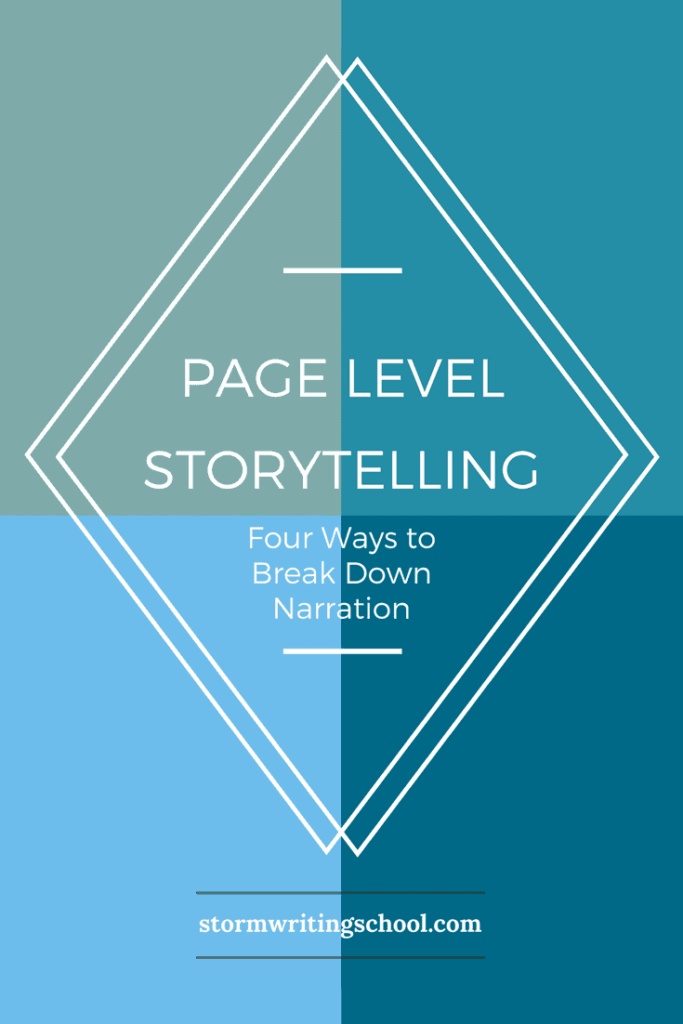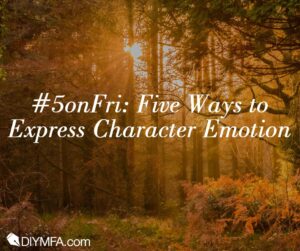Though stories have a sequence and a structure, they are not lists. Sure, you can turn a story into a list:
- I went into the woods
- I heard a twig snap
- I saw a monster
- I ran
- The monster chased me
- I tripped
And so on.
But if your storytelling consists of a simple list of events, you’re in trouble. Scene-writing benefits from some other stuff. What other stuff exactly? Here are four ways to break down what can be included on a page. There’s some overlap between these, but it’s helpful to consider these four breakdowns when you’re crafting your scenes.
1. External vs. internal.
This is perhaps the simplest division—though there’s not always a clear separation between these two concepts. External refers to what’s happening outside of characters’ minds. It’s the stuff that an observer could see. My monster-in-the-woods list above is all external events.
Internal refers to what’s going on inside a character’s head. We often read precisely because we get a view into the inner workings of other people. And it’s this view into the inner machinations of others that makes reading a means of building empathy.
Now, as I said, the division between the external and the internal is not always very straightforward. Smashing a coffee mug on the floor suggests anger; running away from a monster suggests fear. Readers can intuit how a character is feeling given the external context of a situation and the character’s external reaction.
But there are certainly times when it’s helpful to know what a character is thinking, what past situations come to her mind, or what future she anticipates.
2. Scene vs. Summary.
Dwight Swain defines a scene as a “unit of conflict lived through by character and reader.” Scenes unfurl not in “real time” exactly, but in something close to it. That is, we don’t gloss over the dramatized action surrounding the conflict. We instead get to see that action occur at roughly the same pace as it occurs to the character.
During summary, we speed up. We hear the overview. We went to the zoo last week, and JJ loved seeing all the animals, but he freaked out when he saw the aquarium full of cockroaches. That’s summary. See how those events are not dramatized? We’re not experiencing them at the same pace as the character did.
And therein lies the key difference between scene and summary. Scene is closer to character experience. But summary is the territory of the narrator, so it’s not quite as immediate. Both scene and summary are necessary for stories. You could, in fact, tell a whole story in summary, but it would subtract from the immediacy of the experience, therefore creating less tension and insight into character. But not everything in the story deserves the closer scrutiny delivered by scene depiction.
3. Present-Time story vs. Digressions in time.
By “present-time story,” I mean the stuff happening within the time frame of the story’s beginning, middle, end; it’s “present time” to the character, not necessarily to the narrator. If I were to tell you a story, beginning with my 9:00 pm arrival in Pamplona and ending with my 11:00 am departure the next day, about how I ran with the bulls, that 9:00-11:00 time frame is what I’m referring to as the “present.”
Now, if at some point in the story, I talk about having met a Canadian ballerina in Nice, France the week before, that would be a digression from the present time story. Readers tend to track on the present-time events. But a lot of the story’s meaning/significance arises from the digressions to the past or future.
4. Action vs. Information.
This final division is another pretty simple one, but it’s also pretty messy for several reasons. One could argue, in fact, that everything in a story is information; it’s all words, and words communicate information that listeners/readers/watchers digest and makes sense of.
But we can think of this difference between action and information as having to do with dynamism. Action is dynamic; information is static. Let’s say we’re writing a sequence in which a high school student leaves a bomb threat in a bathroom at his school. He borrows some masking tape from his teacher and asks for a bathroom pass; he goes to the bathroom and locks himself in a stall, scribbling a note and taping it to the mirror; half an hour later, the school calls for an evacuation; the student goes outside with everyone else and waits on the football field. The story’s action would include everything this character does. But the story may contain information coming in various forms—descriptions of setting or characters, revelations of mental or physical states, background information on the setting, situation, character, and/or relationships, etc.
Yes, information overlaps with some of my previous distinctions; information can be internal stuff and it can certainly be a digression in time if it’s background info. But there is also information that doesn’t fit into any of my previous categorizations, which is why I add this fourth distinction. And I’ve seen a lot of writers get swept up in static info dumps, which stall the action entirely, so I think it’s worth pointing out this final distinction.
See my four posts delving deeper into each of these breakdowns:

SaveSave







5 Responses
Hi, (french girl here, please pardon my english) i’ve been learning the craft and at first i had a really hard time understand what was an ” action ” i now finally get it ” something someone does with a PURPOSE ” but i still have a hard time understand what is an ” EVENT ” and what is not, what are the types of events and can a scene be composed of multiples events or only one. All those questions are actually indering my progress in learning the craft and i love the way you explain stuff, it is clear and with a lot of example which is how i learn most. Now i know event is something kid school level but let’s say i had a pretty weird life meaning that even kid school was not something i had the luxary to be part of, all of that to say i would love if you could help me with the understanding of what event are so that i can quickly and easily identify them in stories… ( I’m willing to pay )
Thank you in advance.
Hi Jessie. I’m not sure that “story events” is a term that has clear delineations within the world of creative writing. I think of story events as significant happenings that contribute to the cause/effect chain within a story. We can think of them on any scale. For instance, you could boil down a novel to 10-20 significant events. But you could also zoom in a little more and see every scene as a significant story event (if the scene isn’t significant, why is it in the story?). And then, yes, you could examine a scene and find within it a series of important story events at the smaller scale. Stories are fractals (see this article from Mythcreants for a good explanation of stories as fractals: https://mythcreants.com/blog/your-plot-is-a-fractal/). So when I speak of story events, I’m thinking mostly along the lines of a causal chain of events. Happy to consult with you more about this. Email me at td@stormwritingschool.com and we can set up an appointment.